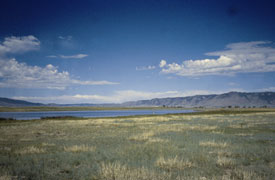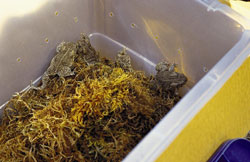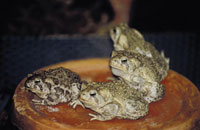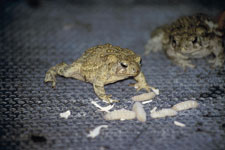A great deal of work remains to be done if the Wyoming toad is to recover to the point that it can be removed from the endangered species list.
Imagine for a moment, maybe 7,000 years ago or so, a group of Paleo-Indians had just concluded a successful hunt in the Laramie Basin, located in what is now southeast Wyoming. As they hunkered down to roast some freshly butchered bison steaks in a fire, they might have cocked their heads to one side in order to better pick up the trill choruses of Bufo baxteri – better known as the Wyoming toad.
The Wyoming toad appeared in the Laramie Basin and speciated roughly 10,000 years ago after it was cut off from its original parental stock – the Canadian toad (B. hemiophrys) – at the close of the Pleistocene. Currently, the ranges of the two species are about 500 miles apart. The Wyoming toad, up until the early 1970s, inhabited the floodplains of the Big and Little Laramie rivers, as well as associated small ponds and watery ditches in a small area of Albany County, Wyoming.

USFWS
Mortenson Lake, in the Laramie Basin, southeast Wyoming, is the last-known locale of wild Bufo baxteri. It is also a current release site of captive-bred Wyoming toads.
Prelude to Extinction
The Wyoming toad was first studied in 1946 by George T. Baxter, a graduate student with the University of Wyoming's zoology and physiology department (at that time it was still considered a subspecies of the Canadian toad; it achieved species status in 1997 [Smith, et al, 1997]). It was considered common through the early 1970s, and was often observed along the Little and Big Laramie rivers and associated floodplains. Then, all of a sudden, and no one seems to know quite why, something began taking Bufo baxteri out of the wilds of Wyoming.
By the late 1970s the toads were becoming more scarce. In 1984 the situation was so grave that the Wyoming toad was federally listed as an endangered species. In fact, the 2-inch-long (females tend to be slightly larger than males), variably colored (dark brown, gray or green) toads with the distinct dark blotching and light median lines were considered extinct, thus joining the procession of more than 500 species of plants and animals to become extinct since the arrival of the Virginia colonists.
Then, a ray of hope: A wild breeding population was discovered at Mortenson Lake in 1987. Surveys conducted in 1987 and 1988 revealed a group of Wyoming toads of various ages. Mark-and-recapture surveys performed by Corn and Withers in 1990 and 1991 showed the Mortenson Lake population to be in decline. Prior to becoming a national wildlife refuge, Mortenson Lake was privately owned by rancher Charlie Swanson (now a toad recovery team member), who leased the lake to a private fishing club and grazed his cattle on acreage surrounding the lake.
"We are in the process of reverting the management of the refuge back to what it once was. The lack of grazing appears to have had a negative affect (Withers, 1992) on the toads' ability to breed and bask," said Michelle Geraud, Wyoming Toad Recovery Coordinator with the U.S. Fish and Wildlife Service.
First Toad Refuge
Enter The Nature Conservancy, which secured the funds necessary to purchase this last B. baxteri stronghold in 1991. The site formed the nucleus of the Mortenson Lake National Wildlife Refuge in 1993, when the federal government purchased it.
The nearly 1,800-acre refuge, as well as a recently granted private research/release site, are currently the only Wyoming toad habitat. The Mortenson Lake refuge consists of four bodies of water: Mortenson Lake, Garber Lake, Gibbs Pond and Soda Lake. The refuge was acquired under the authority of the Endangered Species Act solely for the benefit of the Wyoming toad. By May 2002, 56 similar refuges were acquired on behalf of threatened and endangered plants and animals.

USFWS
The hope of a species could rest with this group of Bufo baxteri. Perhaps this is the group that will re-establish a healthy, viable breeding group in the wild.
During the summers of 1994 and 1995, additional searches were conducted in the Laramie Basin with no additional toads being found outside of Mortenson Lake. So, as of 1995, the entire range of Bufo baxteri consisted of a two-mile-square area around Mortenson Lake, and it remains so to this day (with the exception of the private research site).
The American Zoo and Aquarium Association (AZA) signed off on a formal Species Survival Plan (SSP) for the Wyoming toad in 1996. This plan involves a coordinated approach that includes captive breeding, education, habitat preservation, research and releases back into the wild.
In 2001, the Wyoming Toad Recovery Team (WTRT) was established, with individual members being appointed by the Regional Director of the USFWS. At present, the WTRT includes representatives from the Wyoming Game and Fish Department, U.S. Fish and Wildlife Service (USFWS), Fish and Wildlife Assistance Office, a private landowner, the Laramie Rivers Conservation District, Wyoming Natural Diversity Database, the University of Wyoming, the San Diego Zoo and the AZA.
In-House Toads
The Sybille Wildlife Research Center (formerly funded by Wyoming Game and Fish, but now under the auspices of USFWS), in Wheatland, first took Wyoming toads into captivity in 1989. In 1993 a much more intensive captive-breeding program was undertaken with 12 wild-caught individuals, now widely believed to be the last of their kind.
The program began to yield results in 1998, when four egg masses were found at the Mortenson Lake release site and again in 1999 with the discovery of two additional egg masses. By the spring of 1998, numerous toads that were captive hatched and released could be heard calling at Mortenson Lake – a prelude to breeding activity – for the first time in the wild since 1993.
In 1997, the Saratoga National Fish Hatchery became the first (and currently only) federal hatchery to participate in the breeding of endangered amphibians. From 1993 to 2003, the two Wyoming toad breeding facilities produced tadpoles and toadlets, all of which were released into either Mortenson Lake, Lake George (located at the nearby Hutton Lake National Wildlife Refuge) and a private release site (see box for tallies).
The captive-breeding program has ballooned, and many facilities across the country now possess captive toads for brood stock. They include New York's Central Park Zoo, the Cheyenne Mountain Zoo (Colorado Springs, Colorado), Detroit Zoo, Henry Doorly Zoo (Omaha, Nebraska), Houston Zoo, Sedgwick County Zoo (in Kansas), St. Louis Zoo, Toledo Zoo, Sybille Wildlife Research Center and Saratoga National Fish Hatchery (in Saratoga, Wyoming).
The Prospect Park Zoo manages the studbook, the SSP veterinarian is out of the Phoenix Zoo and the program's pathologist is from the San Diego Zoo. The SSP coordinator is from the Philadelphia Zoo, which is now housing toads (but not breeding them). And the Memphis Zoo provides the program's reproductive advisor. Memphis Zoo staff were recently permitted to conduct reproductive research on some of the toads.

USFWS
This grim-faced quartet bide their time at the Saratoga Fish Hatchery. Until Batrachochytrium dendrobatidis – implicated in amphibian declines worldwide – is eradicated from release sites, prospects for the Wyoming toad in the wild are dicey.
The optimism of those involved in the program tends to be guarded. "The cooperative efforts today have kept the toad from going extinct and those efforts should be commended," said Geraud. "However, there is still much we do not know about the toad and the chytrid fungus that is hindering our progress." (The chytrid fungus Batrachochytrium dendrobatidis, also known as BD, is a major factor behind worldwide amphibian decline.)
Roadblocks to Recovery
If you were strolling beside Big Laramie River in the early 1970s, you might have heard one of three distinct calls that male Wyoming toads emit (females do not vocalize). According to Baxter's original observations, males produce a brief buzzing trill when mating; a deeper gular sound is made when other males mistakenly mount males. In another study (Withers, 1992), males were found capable of producing a third call, a staccato pip sound used as a protest call. Unfortunately, these once-familiar spring and summer calls are now faint recollections for many Wyomingites.
Aerial spraying to control mosquitoes, agricultural practices (including wetland re-engineering for irrigation, although this has also created new toad habitat in some instances), increased predation from introduced fish and other predators, disease (including BD) and climatic changes are all possible contributors to the Wyoming toads' free fall toward extinction. Even so, no concrete evidence exists to prove conclusively the cause of their decline.
It's interesting to note that the last wild population of Bufo baxteri was found at Mortenson Lake – one of the few areas within the Laramie Basin not being subjected, at the time the toads were found, to aerial spraying of fenthion to control mosquitoes.
Fenthion is extremely toxic to fish, amphibians and aquatic invertebrates (a major food source for the toads) and was banned outright by the Environmental Protection Agency after 1992 – too late for the toads. Spraying malathion (another pesticide dangerous to the toads) has been banned on the Mortenson Lake refuge, and the private landowners adjacent to the refuge refuse to have it sprayed over their lands as well.
The most ominous threat to the toads' reintroduction is the presence of BD at Mortenson Lake. The fungus is thought to have been present there since at least 1989. "The presence of the chytrid fungus at Mortenson Lake may very well explain why the population there has never really taken off," said Geraud.

USFWS
This captive-bred-and-raised Bufo baxteri is being fattened up with some tasty wax worms prior to its release.
Future Prospects
"We do not know exactly where the toad hibernates or what conditions are present in the wild hibernacula," said Geraud. "There have been in-depth hibernation studies conducted with the closely related Canadian toad; however, we are not sure how that applies to the Wyoming toad. It is reasonable to think that after being geographically separated for as long as they have that life history traits may vary somewhat."
One of the most important aspects in the toads' recovery is finding new release sites. In order to accomplish this, more local and regional concerns will need to be addressed. According to Geraud, involvement from county, private and local groups has been pretty low. "I think that this is due to a lack of outreach on our part," she said. Geraud would like to see more aggressive grassroots outreach programs developed.
"Aside from a lack of knowledge about basic life history information," she said, "we also are lacking knowledge relating to all aspects of the amphibian BD fungus. At this point, the amphibian BD fungus is considered the largest factor limiting the recovery of the Wyoming toad."
Gaining Ground
The 2002 spring "toad search" at Mortenson Lake, conducted by USFWS biologists, Wyoming Game and Fish personnel, University of Wyoming personnel and interested volunteers, discovered 52 yearling toads and four adults. The previous year about 8,338 tadpoles, toadlets, metamorphs and yearlings were released at the same site. While release results have been less than stellar, the production of captive-born tadpoles has been nothing short of spectacular. Additionally, the participation of one state facility has grown to include at least 10 more dedicated to saving Bufo baxteri.
The latest Wyoming toad survey, conducted August 29, 2003, revealed 228 toads of various ages.
"Although there are many unknowns in the world of Wyoming toad husbandry, the number of tadpoles produced by the SSP in the last three years (2000 to 2002) has exploded," said Geraud. "For example, the SSP released more animals last year (8,338 in 2001) than in the years 1996 to 1999 (8,255 animals), combined. This trend has been holding steady since 2000." Case in point: This past year (2003) a total of 7,203 toads were released in the Basin.
Lessons Learned
Not wanting to wait until the eleventh hour, as was done with the Wyoming toad, the Saratoga Hatchery, under the guidance of the Boreal Toad Recovery Team, has recently initiated a captive-breeding program for the southern Rocky Mountain boreal toad (Bufo b. boreas).
Batrachochytrium dendrobatidis has been discovered among various populations, especially in the Northwest and in neighboring Colorado. Die-offs have been occurring throughout the toad's range (at least one active breeding colony has been identified in southern Wyoming).
As with the Wyoming toad, a combination of factors are working in concert against the boreal toad. Right now, in Colorado, BD seems to be the major cause of this species' decline; it was recently documented in wild Wyoming boreals of the Southern Rocky Mountain population.
Ongoing Efforts
Research and conservation activities on behalf of Bufo baxteri continue. The Arapaho National Wildlife Refuge recently completed a survey of BD in the Laramie Basin. The resulting information will assist the WTRT in determining if BD-free sites exist and will allow the USFWS to release tadpoles to sites that are either BD free or where the disease has a lower prevalence.
Also, 2003 marks the first time in the recovery program's history that an individual has granted permission to allow toads to be released on private land and the first time that toads have been released outside of the refuge system. This agreement allows animals to be released for the next three years in order to better study the impact of BD on toads in the wild.
The state of Wyoming has hired a herpetologist who plans to study BD on a statewide basis. And the Saratoga facility has been involved in an analysis of water samples taken from its tanks during egg laying, hatching and metamorphosis. Water chemistry and breeding success rates are to be compared among those facilities participating in the study. The hope is that more data will be uncovered regarding the range of water-chemistry values that B. baxteri is able to tolerate, thus realizing across-the-board improvements in breeding success rates.
Ongoing research as to whether or not hypovitaminosis A is present among captives toads continues. Additional research conducted at Mortenson Lake (in 2003) determined that, based on gut contents, ants were a main food source for the toads. Further work will determine the nutritional makeup of the ants, which could aid in providing better diets for captives. At the same time, a nutritionist has been analyzing the diets and supplements that all institutions housing Wyoming toads feed their captives. Additional research is planned for 2004.
The Laramie Rivers Conservation District (LRCD) will continue to educate local landowners about the conservation practices best suited for providing the best long-term outlook for the toads.
The WTRT will continue to rewrite and update the recovery plan as additional information becomes available. "If all goes well, the revision to the plan should hit the federal register in six months," said Geraud.
The Wyoming Toad Recovery Team, SSP and FWS will continue to develop the best criteria in establishing new release sites.
Conclusion
So where does the Wyoming toad go from here?
"The FWS and the LRCD have been working closely to develop a Safe Harbor Agreement for the Wyoming toad in Albany County, Wyoming," said Geraud. "I just finished revising all necessary documents based upon legal review. We are hoping to have everything finalized prior to the 2004 breeding/release season. This will create a mechanism to find more release sites for the toads while lessening the burden on private landowners. So far, five landowners have expressed interest, and the largest site is 300 acres.
"Although I know the toad will not be delisted any time soon, I can foresee a time when it will," Geraud said.
A great deal of work remains to be done if the Wyoming toad is to recover to the point that it can be removed from the endangered species list. Slowly but surely, the trills and pips of Bufo baxteri are coming back to the wilds of Wyoming.
References
Smith, H. M., D. Chizar, J. T. Collins and F. van Breukelen. 1997. "The taxonomic status of the Wyoming toad, Bufo baxteri Porter." Contemporary Herpetology (online journal); 1:1.
Withers, D. I. 1992. "The Wyoming toad (Bufo hemiophrys baxteri); an analysis of habitat use and life history." University of Wyoming master's thesis.
Special thanks to Michelle Geraud and Dee Dee Runner of the USFWS for supplying much of the article content, submitting numerous photos and for reviewing the article.


